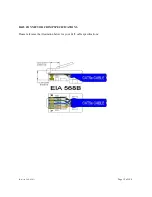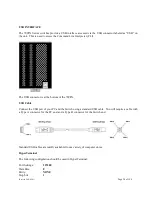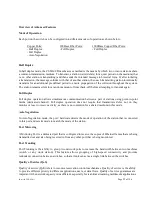
(Revised 2012-05-01)
Page 25 of 196
functionality. Multicasting allows one computer to send content to multiple other computers that have
identified themselves as interested in receiving the originating computer's content. Multicasting can be used
to transmit only to an audience that has joined (and not left) a multicast group membership. IGMP version 2
is formally described in the Internet Engineering Task Force (IETF) Request for Comments (RFC) 2236.
IGMP version 1 is formally described in the Internet Engineering Task Force (IETF) Request for Comments
(RFC) 1112. The 709FX series supports v1 and v2.
N-Ring
N-Ring is enabled by default, and the switch is Plug and Play for N-Ring except that initially one must
enable an N-Ring enabled device to be the N-Ring Manager for a given N-Ring. Subsequently, N-Ring
operates dynamically upon each power up. Using N-Tron's proprietary N-Ring technology offers expanded
ring size capacity, detailed fault diagnostics, and a standard healing time of 30ms. The N-Ring Manager
periodically checks the health of the N-Ring via health check packets. If the N-Ring Manager stops
receiving the health check packets, it times out and converts the N-Ring to a backbone within 30ms. When
using all N-Ring enabled switches in the ring, a detailed ring map and fault location chart is also provided
on the N-Ring Manager’s web browser. N-Ring status is also sent from the N-Ring Manager to the N-View
OPC Server to identify the health status of the ring. Up to 250 N-Ring enabled switches can participate in
one N-Ring topology. Switches that do not have N-Ring capability may be used in an N-Ring, however the
ring map and fault location chart cannot be as detailed at these locations.
N-Link
The purpose of N-Link is to provide a way to redundantly couple an N-Ring topology to one or more other
topologies, usually other N-Ring topologies. Each N-Link configuration requires 4 switches: N-Link
Master, N-Link Slave, N-Link Primary Coupler, and N-Link Standby Coupler. N-Link will monitor the link
status of the Primary and Standby Coupler links. While the Primary Coupler link is healthy, it will forward
network traffic and the Standby Coupler link will block network traffic. When a problem is detected on the
Primary Coupler link, the Primary Coupler link will block network traffic and the Standby Coupler link will
forward network traffic. While the N-Link Master and Slave are in communication via the Control link,
only one Coupler link (Primary or Standby) will forward network traffic while the other Coupler link will
block network traffic.
CIP
The CIP (Common Industrial Protocol) feature allows N-Tron switches to directly provide switch
information and configuration access to Programmable Logic Controller (PLC) and Human Machine
Interface (HMI) applications via a standardized communication protocol. For example, a PLC may be
programmed to monitor port links or N-Ring status and cause a status indicator to turn red on an HMI if a
port goes link down or if N-Ring has a fault. CIP is formally described in ODVA Publication Number
PUB00001 (Volume 1: Common Industrial Protocol (CIP™)), and Publication Number: PUB00002
(Volume 2: EtherNet/IP Adaptation of CIP). N-Tron provides EDS and ICO files. N-TRON_CIP_Tags.pdf
is for a particular environment, but reveals the tags available.
DHCP
Summary of Contents for 709FX Series
Page 1: ...709FX Managed Industrial Ethernet Switch User Manual Installation Guide...
Page 21: ...Revised 2012 05 01 Page 21 of 196 Flow Control NONE...
Page 32: ...Revised 2012 05 01 Page 32 of 196...
Page 34: ...Revised 2012 05 01 Page 34 of 196...
Page 39: ...Revised 2012 05 01 Page 39 of 196 Administration SNMP Continued...
Page 43: ...Revised 2012 05 01 Page 43 of 196...
Page 44: ...Revised 2012 05 01 Page 44 of 196 DHCP Server Setup Profiles Continued...
Page 45: ...Revised 2012 05 01 Page 45 of 196...
Page 48: ...Revised 2012 05 01 Page 48 of 196 DHCP Server Setup IP Maps Continued...
Page 50: ...Revised 2012 05 01 Page 50 of 196...
Page 55: ...Revised 2012 05 01 Page 55 of 196 DHCP Relay Local IP Setup Continued...
Page 61: ...Revised 2012 05 01 Page 61 of 196 Ports Configuration Continued...
Page 68: ...Revised 2012 05 01 Page 68 of 196...
Page 77: ...Revised 2012 05 01 Page 77 of 196...
Page 82: ...Revised 2012 05 01 Page 82 of 196...
Page 96: ...Revised 2012 05 01 Page 96 of 196...
Page 98: ...Revised 2012 05 01 Page 98 of 196 The user can specify the manual router ports...
Page 100: ...Revised 2012 05 01 Page 100 of 196...
Page 102: ...Revised 2012 05 01 Page 102 of 196 IGMP RFilter Continued Modifying rfilter port settings...
Page 111: ...Revised 2012 05 01 Page 111 of 196...
Page 116: ...Revised 2012 05 01 Page 116 of 196...
Page 124: ...Revised 2012 05 01 Page 124 of 196...
Page 126: ...Revised 2012 05 01 Page 126 of 196...
Page 128: ...Revised 2012 05 01 Page 128 of 196...
Page 131: ...Revised 2012 05 01 Page 131 of 196...
Page 133: ...Revised 2012 05 01 Page 133 of 196...
Page 136: ...Revised 2012 05 01 Page 136 of 196...
Page 139: ...Revised 2012 05 01 Page 139 of 196...
Page 142: ...Revised 2012 05 01 Page 142 of 196...
Page 145: ...Revised 2012 05 01 Page 145 of 196 If a Configuration Device is present that is presented...
Page 181: ...Revised 2012 05 01 Page 181 of 196...






























